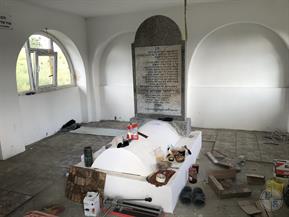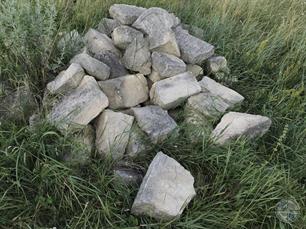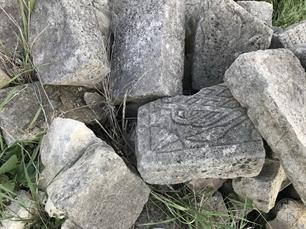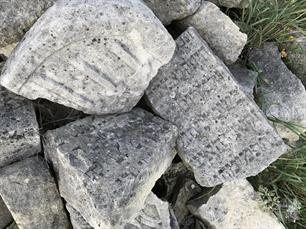Yahilnytsia
Chortkiv district, Ternopil region
Sources:
- Pinkas Hakehillot Polin: Encyclopedia of Jewish Communities, Poland, Volume II, page 279, published by Yad Vashem, Jerusalem. Translated by Shlomo Sneh and Francine Shapiro, JewishGen, Inc.
Photo:
- Hryhoriy Arshynov, European Jewish Cemeteries Initiative, 2019
- Center for Jewish Art, Jewish cemetery in Yahilnytsia
- Pinkas Hakehillot Polin: Encyclopedia of Jewish Communities, Poland, Volume II, page 279, published by Yad Vashem, Jerusalem. Translated by Shlomo Sneh and Francine Shapiro, JewishGen, Inc.
Photo:
- Hryhoriy Arshynov, European Jewish Cemeteries Initiative, 2019
- Center for Jewish Art, Jewish cemetery in Yahilnytsia
Year - Total Population - Jews
1765 - (?) - 347
1880 - 3,143 - 1,892
1890 - 3,201 - 1,759
1900 - 3,083 - 1,366
1910 - 3,027 - 1,284
1921 - 2,702 - 988
1935 - 9,783 - 1,066
1765 - (?) - 347
1880 - 3,143 - 1,892
1890 - 3,201 - 1,759
1900 - 3,083 - 1,366
1910 - 3,027 - 1,284
1921 - 2,702 - 988
1935 - 9,783 - 1,066
The Jewish Community from its beginning to the Second World War
Jagielnica is first mentioned in documents from 1488, when the Polish king visited it. It was awarded the rights of a private town of the nobility in 1517.Between the years 1669-1672 the Turks governed it. In 1772 Austria became the ruler. In 1929 it was united with a few villages in the area. In this way the total population grew three times, but the growth of the Jewish population was very small.
The information about Jewish settlement in Jagielnica begins only from the eighteenth century. At the end of that century, Rabbi Dovid, author of Brachot David (David's Blessings), was then the rabbi and the head of the Rabbinical Court. After him, from 1780 until 1903, the town was headed by the rabbinical dynasty of the Shapira family.
The first of them was Rabbi Zvi, and after him came Rabbi Israel, his son, his grandson, Rabbi Shmuel Ze'ev, and his son, Rabbi Zvi. The fifth generation of the Shapira dynasty, Rabbi Menachem, was also the Rabbi of Jagielnica, at the beginning of his career, but in 1903 he changed residences to become the Rabbi of Horodonka. In the twentieth century the rabbi there was Rabbi Shmuel Melamed.
The Jews of Jagielnica, like other Jews of the area, made their living through trade and artisanship. At the end of the nineteenth century two factories were established there: one for bricks and the other for tobacco, whose workers were not Jews. A Jew who was a soldier in Pilsudski's Legions in the 1920's applied to be a worker in the tobacco factory, but he was refused employment.
In 1904 there was a fire in the town center where the Jews lived. Twenty buildings burnt up, and fifty families became homeless.
Jagielnica is first mentioned in documents from 1488, when the Polish king visited it. It was awarded the rights of a private town of the nobility in 1517.Between the years 1669-1672 the Turks governed it. In 1772 Austria became the ruler. In 1929 it was united with a few villages in the area. In this way the total population grew three times, but the growth of the Jewish population was very small.
The information about Jewish settlement in Jagielnica begins only from the eighteenth century. At the end of that century, Rabbi Dovid, author of Brachot David (David's Blessings), was then the rabbi and the head of the Rabbinical Court. After him, from 1780 until 1903, the town was headed by the rabbinical dynasty of the Shapira family.
The first of them was Rabbi Zvi, and after him came Rabbi Israel, his son, his grandson, Rabbi Shmuel Ze'ev, and his son, Rabbi Zvi. The fifth generation of the Shapira dynasty, Rabbi Menachem, was also the Rabbi of Jagielnica, at the beginning of his career, but in 1903 he changed residences to become the Rabbi of Horodonka. In the twentieth century the rabbi there was Rabbi Shmuel Melamed.
The Jews of Jagielnica, like other Jews of the area, made their living through trade and artisanship. At the end of the nineteenth century two factories were established there: one for bricks and the other for tobacco, whose workers were not Jews. A Jew who was a soldier in Pilsudski's Legions in the 1920's applied to be a worker in the tobacco factory, but he was refused employment.
In 1904 there was a fire in the town center where the Jews lived. Twenty buildings burnt up, and fifty families became homeless.
The Second World War
In September and October 1939, the first month of the Soviet rule, it seems that Jewish settlement in Jagielnica grew to about 2,000 people because of the flow of refugees from the areas of western Poland. It is certain many of these refugees were then sent by the Soviet authorities in the summer of 1940 to far-off areas of the Soviet Union.
When the Germans occupied Jagielnica on June 7, 1941, they began to arrest Jews on the pretext that they were pro-Communist activists during the Soviet rule. A large group of men were sent to the jail in Chortkov, and tortured there. The majority of prisoners in this jail quickly died, and the rest were sent to work camps, and also died there. Only a few of those imprisoned remained alive, the reason being the large ransom their families paid. A few expert artisans were not killed because they were vital to the Germans.
A short time after the occupation the Germans designated a Judenrat, but their names are unrecorded. The heavy nightmare of Jagielnica Jewry during the time of the German occupation, consisted of manhunts and banishment to work camps, where conditions were murderous. The majority of the young men were banished from the town to these camps. The adults were forced to work for the Germans in the town and the area. Many of the Jews of Jagielnica (including also women) were worked in the spring and summer of 1942 worked on the farms in the area, and raised coksagize, a substitute for rubber, which was brought there by the Soviets because the land was suitable for growing this plant. Jagielnica had an office of J.J. Kaochuck, which administered all the coksagize plantations in the area, except in Jagielnica. Jews from the region were sent to work in these plantations, among them many girls and women. The majority of these workers worked on these plantations only during the agricultural season, and afterwards returned to their homes. Groups of Jews were lived together near the farms, and they had a collective kitchen and budget. Their diet was sufficient. The Jagielnica Judenrat had a permanent connection with Judenrats in other places, since there were also seasonal workers who were not from Jagielnica.
The Germans forced the Jews of Jagielnica to give them money and jewelry several times, and the Judenrat was forced to accede to their demands. In the winter of 1941-42 the Germans confiscated furs from the Jews. Afterwards they killed some Jews when it was discovered that they did not relinquish their furs to them. Jagielnica was not the place of any German authority, but the Jews suffered greatly from the cruelty of the local Ukrainian policemen, and the surprise visits of German officials from other cities, who broke into homes, took whatever they wanted, and tortured the Jews they met. But the majority of Jagielnica Jews did not suffer from hunger because there was no ghetto, and the work on the estates of the area gave them the opportunity of links to local farmers, secret trade, and buying food.
It seems that the Jewish settlement was exterminated during the autumn of 1942 (September and October), two Aktions which included the majority of Jagielnica and nearby village Jews. It seems that the Jews who were caught in these Aktions were sent to Belzec extermination camp. The rest, who were not involved in these Aktions, were ordered to disperse in cities that had ghettos. (It is not clear if survival was to due to hiding when there were selections by the Germans.) And really, it is known that in October-November, Jagielnica's Jews came to Tlosta.
At the same time there was a series of selections in the camps near the estates in the area. The majority of the workers that were not needed any more after the agricultural season ended were shot. There were executions all over the region.
Only a few remained alive for a short time, mainly expert artisans. The Germans concentrated them again in groups, which were signed with special letters, and assigned to work in several services. Thanks to very stiff bribes, the minority of Jews had such jobs, but gradually this remnant also was eliminated. A considerable number of Jews escaped, hid in the forest, in the fields, in abandoned houses, in attics, and wherever they found a place, or bunkers, which were prepared ahead of time.
The majority of those who were still hidden died because of informers (snitches). Others were discovered by the German-Ukrainian policemen, or because of cold or weakness.
Only a few lucky people with money succeeded in getting help and haven in the homes of local farmers, and could persevere until the liberation of the town by the Red Army on March 24, 1944.
In September and October 1939, the first month of the Soviet rule, it seems that Jewish settlement in Jagielnica grew to about 2,000 people because of the flow of refugees from the areas of western Poland. It is certain many of these refugees were then sent by the Soviet authorities in the summer of 1940 to far-off areas of the Soviet Union.
When the Germans occupied Jagielnica on June 7, 1941, they began to arrest Jews on the pretext that they were pro-Communist activists during the Soviet rule. A large group of men were sent to the jail in Chortkov, and tortured there. The majority of prisoners in this jail quickly died, and the rest were sent to work camps, and also died there. Only a few of those imprisoned remained alive, the reason being the large ransom their families paid. A few expert artisans were not killed because they were vital to the Germans.
A short time after the occupation the Germans designated a Judenrat, but their names are unrecorded. The heavy nightmare of Jagielnica Jewry during the time of the German occupation, consisted of manhunts and banishment to work camps, where conditions were murderous. The majority of the young men were banished from the town to these camps. The adults were forced to work for the Germans in the town and the area. Many of the Jews of Jagielnica (including also women) were worked in the spring and summer of 1942 worked on the farms in the area, and raised coksagize, a substitute for rubber, which was brought there by the Soviets because the land was suitable for growing this plant. Jagielnica had an office of J.J. Kaochuck, which administered all the coksagize plantations in the area, except in Jagielnica. Jews from the region were sent to work in these plantations, among them many girls and women. The majority of these workers worked on these plantations only during the agricultural season, and afterwards returned to their homes. Groups of Jews were lived together near the farms, and they had a collective kitchen and budget. Their diet was sufficient. The Jagielnica Judenrat had a permanent connection with Judenrats in other places, since there were also seasonal workers who were not from Jagielnica.
The Germans forced the Jews of Jagielnica to give them money and jewelry several times, and the Judenrat was forced to accede to their demands. In the winter of 1941-42 the Germans confiscated furs from the Jews. Afterwards they killed some Jews when it was discovered that they did not relinquish their furs to them. Jagielnica was not the place of any German authority, but the Jews suffered greatly from the cruelty of the local Ukrainian policemen, and the surprise visits of German officials from other cities, who broke into homes, took whatever they wanted, and tortured the Jews they met. But the majority of Jagielnica Jews did not suffer from hunger because there was no ghetto, and the work on the estates of the area gave them the opportunity of links to local farmers, secret trade, and buying food.
It seems that the Jewish settlement was exterminated during the autumn of 1942 (September and October), two Aktions which included the majority of Jagielnica and nearby village Jews. It seems that the Jews who were caught in these Aktions were sent to Belzec extermination camp. The rest, who were not involved in these Aktions, were ordered to disperse in cities that had ghettos. (It is not clear if survival was to due to hiding when there were selections by the Germans.) And really, it is known that in October-November, Jagielnica's Jews came to Tlosta.
At the same time there was a series of selections in the camps near the estates in the area. The majority of the workers that were not needed any more after the agricultural season ended were shot. There were executions all over the region.
Only a few remained alive for a short time, mainly expert artisans. The Germans concentrated them again in groups, which were signed with special letters, and assigned to work in several services. Thanks to very stiff bribes, the minority of Jews had such jobs, but gradually this remnant also was eliminated. A considerable number of Jews escaped, hid in the forest, in the fields, in abandoned houses, in attics, and wherever they found a place, or bunkers, which were prepared ahead of time.
The majority of those who were still hidden died because of informers (snitches). Others were discovered by the German-Ukrainian policemen, or because of cold or weakness.
Only a few lucky people with money succeeded in getting help and haven in the homes of local farmers, and could persevere until the liberation of the town by the Red Army on March 24, 1944.
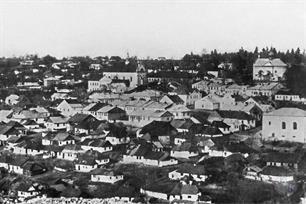 |
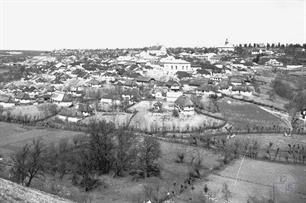 |
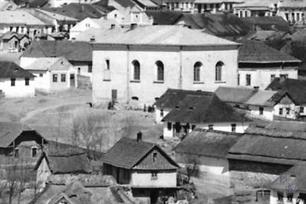 |
| Panorama of the Yahilnytsia of the 1930s. The synagogue on the right | Panorama of 1929. Synagogue in the center on the right | Synagogue was destroyed during World War II |
The Jews of Jagielnica emigrated to the big cities of Galicia or abroad. During the years 1880-1910 the number of Jews dwindled. During the First World War more Jews left the town, and many of them never returned to it. At the beginning of the twentieth century, a self-help organization in Vienna organized the manufacture of hairnets, which gave jobs to some of the women in the town as a home industry. The majority of Jagielnica Jews also continued to make a living between the two World Wars from trade (small trade and peddling) and artisanship. We can learn about the difficult economic circumstances from those who worked, from the fact that all of them needed loans from the Kupat Hagemach-the Free Loan Societies. During the years 1936-1937 this society gave loans to 178 people, and of them 133 were small businessmen, and 45 were artisans.
A Zionist union was established in 1897, and in 1921 branches were established of Hitachdut and Mizrachi. In 1926 Poalei Zion was established. In the mid -1930's the Medina party was also active. Hashomer Hazair was established at the beginning of the 1920's.
In 1924 forty of its members got agricultural training at an estate that was rented by a local Jew. In the middle of the 1930's a branch of Zionist Youth was established.
More than sixty percent of the voters voted for the Eretz Yisroel Oved- (the Histadrut) party. Between the two world wars, Zionists headed the community.
At the beginning of the twentieth century a Jewish school was established there by Baron Hirsh. In 1920 a complementary Hebrew school was established in Jagielnica with approximately 100 pupils.
In Jagielnica there were two cultural associations, one called Tarbut, and the other Kultur Frieind, which sometimes cooperated.
A Zionist union was established in 1897, and in 1921 branches were established of Hitachdut and Mizrachi. In 1926 Poalei Zion was established. In the mid -1930's the Medina party was also active. Hashomer Hazair was established at the beginning of the 1920's.
In 1924 forty of its members got agricultural training at an estate that was rented by a local Jew. In the middle of the 1930's a branch of Zionist Youth was established.
More than sixty percent of the voters voted for the Eretz Yisroel Oved- (the Histadrut) party. Between the two world wars, Zionists headed the community.
At the beginning of the twentieth century a Jewish school was established there by Baron Hirsh. In 1920 a complementary Hebrew school was established in Jagielnica with approximately 100 pupils.
In Jagielnica there were two cultural associations, one called Tarbut, and the other Kultur Frieind, which sometimes cooperated.

- Home
- Shtetls
- Vinnytsia region
- Volyn region
- Dnipro region
- Donetsk region
- Zhytomyr region
- Zakarpattia region
- Zaporizhzhia region
- Ivano-Frankivsk region
- Kyiv region
- Kropyvnytskyi region
- Luhansk region
- Lviv region
- Mykolayiv region
- Odessa region
- Poltava region
- Rivne region
- Sumy region
- Ternopil region
- Kharkiv region
- Kherson region
- Khmelnytskyi region
- Chernihiv region
- Chernivtsi region
- Cherkasy region
- Crimea
- Synagogues
- Cemeteries
- Objects & guides
- Gallery
- History
- Contact
Jewish towns of Ukraine
Jewish towns of Ukraine
My shtetl
My shtetl
Donate

